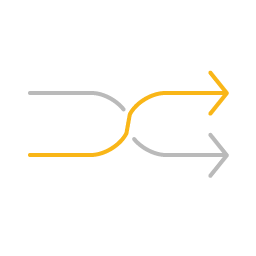GOO® IT Service Manager provides effective platform that is user oriented, integrated with all business departments and capable for supporting of corporate business processes. In organisations, high service quality and reliable corporate support are targeted, that enable you to operate all technical and business processes easily.
IT Service Management

ITIL based GOO® IT Service Manager allows you to manage, observe and measure IT
processes of the companies under the particular discipline.
Expedited Delivery
GOO IT Service Manager provides a new viewpoint for it service management. It turn technical teams from daily fire fighting to delivering well defined customer service in disciplinary way. That leverages organisational service support and lower operational service costs.

Mobile Service Management

Service Management Workflow

Multichannel Service Desk
ITIL Ready Service Desk

Incident Management
In case of unplanned cuts or decrease of service quality in IT services, defining analysis, diagnoses and correction activities, and management of process are very easy with ITIL based Incident Management. If incident happen about operations, services and functions in organisation and right action not taken in right time, incident may turn into crises or tragedy. As soon as possible getting service to live is foundation of job. Incident Management, ITIL based and integrated with other ITIL processes, provide important contribution for sustaining service quality. In this way, you can increase corporate quality by minimising interruptions in your business because of unexpected problems.
Service Desk Functionality
Service Desk, also called as Help Desk, Support Desk or Call Center, is one of the important functions of GOO®. By using this unified contact center, customers can open incident record, submit request, track process interactively, take self service by using knowledge base and frequently asked questions. Besides, that is integrated application used as intranet or extranet information portal. Thanks to enhanced access and identity management, which can be easily defined whom and how will benefit from this system at inside or outside of company.
Problem Management
Problem Management encompasses activities that are used to find root cause of incidents stated in Incident Management and find resolution for these problems. Problem Management in GOO® works integrated with other ITIL processes. For example, frequently repeated incidents and problems rise with change or new version release in assets. Besides, Problem Management has a powerful functional interface with Knowledge Base Management.
Request Management (Request Fulfilment)
Request Fulfilment is predefined, approved and renewed processes. These processes usually can be formed as simple demands (change password, e-mail register etc.) or information requests. On GOO®, requests can be associated with Service Catalog and workflows can be created for. Besides, requests can be grouped according to divisions and forms special to request can be designed online. Also, users send these requests over service desk according to organisational and personal level rights.

Service Asset and Configuration Management
Service Asset and Configuration Management is an important component that manages information and relationships between configuration items for perform IT services. Service Asset and Configuration Management, have firm relationships with other process on GOO®, hold detail technical information of IT inventory as well as belonging information (Who is responsible? Where is it? When guaranty start and end? Etc.). This module basically consists of Configuration Management System and Configuration Management Database. Tracking (repairs or consignment), controlling (replace, scrap) and planning configuration items can be performed. Besides, whole relationship topology can be visualised with the help of links between asset and configurations.
Supplier Management
Supplier Management is a sub module exists on GOO®’s base applications and may be referred during various steps. Your suppliers as a third party are included in all processes from getting services with stakeholder agreements to procure items. Supplier Management basically allows you to hold your partners information and to construct information integrity by relating these records to processes. Thus, in addition to track instantly suppliers also evaluating suppliers’ assets can be made easily by reports which system provides. And, supplier management allows the supplier management team to easily record and track the contracts, with information such as service levels, schedule, warranties, affected configuration items and cost and payment schedule.

Service Level Management
Service Level Management (SLM) encompass processes about closing the deal of Service Level Agreement by negotiating with customer and designing of services according to accepted service level targets. Besides, SLM ensures the eligibility of Operational Level Agreement (OLA) and Underpinning Contract (UC) and monitoring-reporting of service objectives. On GOO® you can define, monitor and report SLA according to contract you did with customer as well create OLA and UC for supporting SLAs.
Service Catalog Management
Service Catalog Management (SCM) enables you to define and organize all business and IT related technical services in company. Service Catalog includes important and correct information, like service detail, status and dependency, about all operational services as well help to operate this processes. GOO® came with Service Catalog Management is highly integrated with other processes. On this tool, business services and technical services (Just for IT) can be defined. In addition, required workflows can be created for request fulfilment and application forms can be designed for each catalog items.

Change Management
One of the important processes of IT Service Management is Change Management that is responsible for changing processes of all hardware, communication tools and software, documents and procedures required for operating, supporting and maintaining of system softwares and live systems. Process, that starts with getting change request, are ended respectively by evaluating affect, cost, benefit and risk, getting approves from authorized persons (CAB), coordinating and managing, observing and reporting, and evaluating and closing.
Event Management
Event Management may be defined as tracking and evaluating events occur on IT infrastructure. With GOO® Event Management, event records, which gathered from legacy network configuration management tools, services or integrated log management tool located on GOO®, can be held on Event Management Database. If rules which we define for evaluating this records work and results pass thresholds, process can be attached to Incident, Problem or Change Management or before incident occur responsible persons can be notified by e-mail, message or other communication tools. Besides, recorded events can be tagged and interpreted as Info, Warning and Error.

Knowledge Management
Knowledge Management (KM) is one of the important factors to reach organisational goals by providing use of knowledge effectively in organisation. On GOO®, collecting, enhancing, sharing and efficiently using of organisational knowledge can be made effectively during every steps of processes. Sometimes, Known Error Database, that is part of KM, can be used for root cause analyses conducted at problem management processes. This database is created in purpose of using effectively permanent knowledge, which is related to incidents’ resolution, for same problems. Besides, Frequently Asked Question (FAQ) in service management function can be fed from knowledge base and work user interactive.
Periodic Processes
Periodic jobs, which is one of the base applications of GOO®, can open maintenance, support, procurement and service records, and can notify you about critic situation by evaluation all system data according to time and status parameters you define online. Daily database backups, weekly checking server performance logs or monthly procurement of consumable materials can be given as examples. In this way, time lost for periodic jobs will be saved and faults rise from personal mistake will be minimised.
